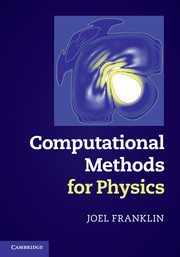Book contents
- Frontmatter
- Dedication
- Contents
- Preface
- 1 Programming overview
- 2 Ordinary differential equations
- 3 Root-finding
- 4 Partial differential equations
- 5 Time-dependent problems
- 6 Integration
- 7 Fourier transform
- 8 Harmonic oscillators
- 9 Matrix inversion
- 10 The eigenvalue problem
- 11 Iterative methods
- 12 Minimization
- 13 Chaos
- 14 Neural networks
- 15 Galerkin methods
- References
- Index
Preface
Published online by Cambridge University Press: 05 July 2013
- Frontmatter
- Dedication
- Contents
- Preface
- 1 Programming overview
- 2 Ordinary differential equations
- 3 Root-finding
- 4 Partial differential equations
- 5 Time-dependent problems
- 6 Integration
- 7 Fourier transform
- 8 Harmonic oscillators
- 9 Matrix inversion
- 10 The eigenvalue problem
- 11 Iterative methods
- 12 Minimization
- 13 Chaos
- 14 Neural networks
- 15 Galerkin methods
- References
- Index
Summary
This book is meant to teach an advanced undergraduate physics major how to solve problems, that they can easily pose and understand, using numerical methods. It is self-contained (within reason) in its presentation of physical problems, so that a reader need not be previously familiar with all of the physical topics covered. The numerical techniques that are presented are complete, without being exhaustive. I have chosen a set of tools that can be motivated easily – some of these, like Runge–Kutta methods for solving ordinary differential equations, are themselves the “end of the story” for certain problems. In other cases, I choose to present a simplified method that will work for at least some problems, even if it is not what is actually implemented in practice. A homogenous and appropriate level of presentation is the goal. Sometimes that allows for a complete and formal discussion, in other cases, I motivate and inform while ensuring that a successful (if not competitive) method is carefully described.
The chapters are defined by computational technique, with chapters covering “Partial differential equations,” “Integration,” “Fourier transform,” “Matrix inversion,” etc. Each chapter introduces a disparate set of physical problems, most of which are “unsolvable” (meaning that there is no closed-form solution expressible in terms of simple functions). I have attempted to draw problems from as wide an array of physical areas as possible, so that in a single chapter, there may be examples from quantum mechanics, E&M, special relativity, etc.
Information
- Type
- Chapter
- Information
- Computational Methods for Physics , pp. xiii - xviiiPublisher: Cambridge University PressPrint publication year: 2013
